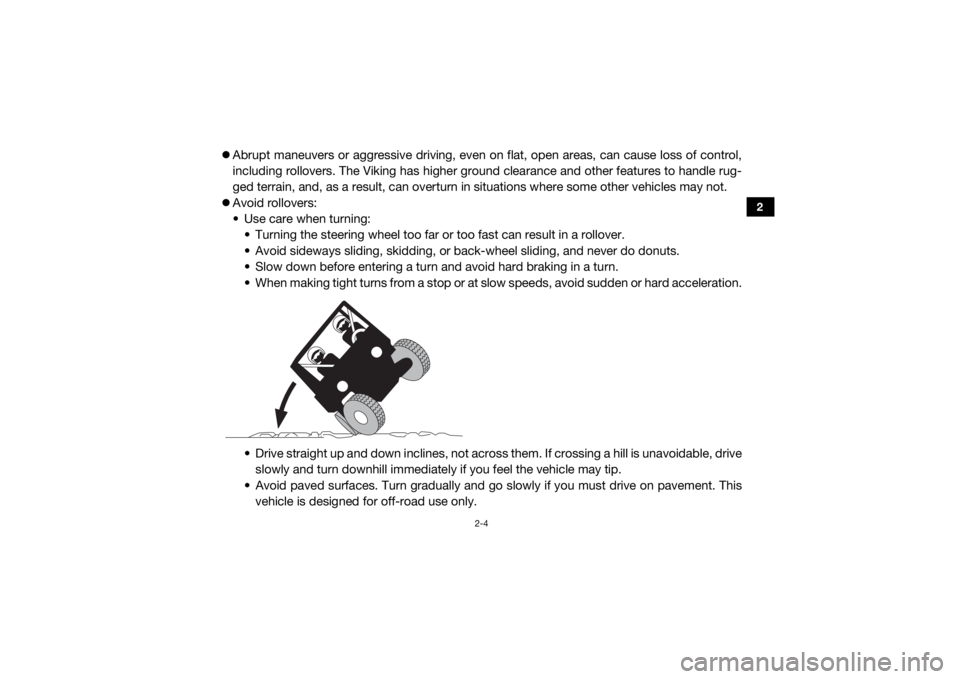Page 29 of 172

2-4
2
Abrupt maneuvers or aggressive driving, even on flat, open areas, can cause loss of control,
including rollovers. The Viking has higher gro und clearance and other features to handle rug-
ged terrain, and, as a result, can overturn in situations where some other vehicles may not.
Avoid rollovers:
• Use care when turning:
• Turning the steering wheel too far or too fast can result in a rollover.
• Avoid sideways sliding, skidding, or back-wheel sliding, and never do donuts.
• Slow down before entering a turn and avoid hard braking in a turn.
• When making tight turns from a stop or at sl ow speeds, avoid sudden or hard acceleration.
• Drive straight up and down inclines, not across them. If crossing a hill is unavoidable, drive
slowly and turn downhill immediately if you feel the vehicle may tip.
• Avoid paved surfaces. Turn gradually and go slowly if you must drive on pavement. This
vehicle is designed for off-road use only.UB427AE0.book Page 4 Monday, May 18, 2015 9:17 AM
Page 30 of 172

2-5
2
If you think or feel that the vehicle may tip or ro ll, keep your body completely inside the protec-
tive structure of the vehicle:
• Brace yourself by pressing your feet firmly on the floorboard and keep a firm grip on the
steering wheel or passenger handhold.
• Do not put your hands or feet outside of the vehicle for any reason. Your arm or leg could be
crushed.
• Do not try to stop a vehicle tipover using your arm or leg.
Do not operate this vehicle on any public street, road, or highway, even if dirt or gravel.
Do not operate the vehicle in fast-flowing water or water deeper than 37 cm (15 in). If you must
cross shallow, slow-moving water, choose your path carefully to avoid sharp drop-offs, large
rocks, or slippery surfaces. Operating this vehi cle through deep or fast-flowing water can lead
to loss of control or overturn. To reduce your risk of drowning or other injuries, use care when
crossing through water.
When loaded with cargo or towing a trailer:
• Reduce speed, operate in low gear only, and allow more room to stop.
• Avoid hills and rough terrain. Use extreme caution when towing or carrying a load on inclines.
• Load trailer properly and use extra care when towing or pulling.
Do not tow or pull objects from any part of the vehicle other than the trailer hitch bracket or
winch (if installed).
Avoid carbon monoxide poisoning
All engine exhaust contains carbon monoxide, a deadly gas. Breathing carbon monoxide can
cause headaches, dizziness, drowsiness, nausea, confusion, and eventually death.UB427AE0.book Page 5 Monday, May 18, 2015 9:17 AM
Page 35 of 172
3-3
3
EBU31200Controls and instrumentsThe vehicle you have purchased may differ slightly from those shown in the figures of this man-
ual.
10
9
2
3
4
5
6,7
8
1
15
13
11
1214
1. Light switch
2. On-Command drive knob
3. Steering wheel
4. Main switch
5. Parking brake lever
6. Helmet indicator light
7. Seat belt indicator light
8. Drive select lever
9. Accelerator pedal
10.Brake pedal
11.Multi-function meter unit
12.Passenger handhold
13.Glove compartment
14.Auxiliary DC jack
15.Storage compartmentUB427AE0.book Page 3 Monday, May 18, 2015 9:17 AM
Page 37 of 172
4-2
4
EBU31260Indicator lights and warning lights
EBU31270Low-range indicator light “L”
This indicator light comes on when the drive
select lever is in the “L” position.EBU31280High-range indicator light “H”
This indicator light co mes on when the drive
select lever is in the “H” position.
1. On-Command differential gear lock indicator light “DIFF.
LOCK”
2. Low-range indicator light “L”
3. High-range indicator light “H”
4. Neutral indicator light “N”
5. Reverse indicator light “R”
6. Parking brake indicator light “ ”
7. On-Command four-wheel-drive/differential gear lock indicator “ ”/“ ”
8. Engine trouble warning light “ ”
9. Coolant temperature warning light “ ”
10.Electric Power Steering warning light “EPS”356421
7
8109
1. Helmet indicator light “ ”
2. Seat belt indicator light “ ”
21
UB427AE0.book Page 2 Monday, May 18, 2015 9:17 AM
Page 40 of 172

4-5
4
EBU33040Electric Power Steering warning light
“EPS”
This warning light comes on when the key is
turned to “ ” (on), and then goes off once
the engine is started. If the warning light re-
mains on or comes on after the engine is
started, the EPS system may not be working
correctly. When this occurs, have a Yamaha
dealer check the EPS system.
The electrical circuit of the warning light can
be checked by turning the key to “ ” (on). If
the warning light does not come on, have a
Yamaha dealer check the electrical circuit.TIPIf the steering load is too heavy (i.e., exces-
sive steering use when the Viking is traveling
at a slow speed), the power assist is reduced
to protect the EPS motor from overheating.
EBU31360Helmet indicator light “ ”
The indicator light comes on and stays on
while the key is turned to “ ” (on) to remind
the occupants to always wear a helmet. If the
indicator light does not come on when the key
is turned to “ ” (on), have a Yamaha dealer
check the electrical circuit.EBU31370Seat belt indicator light “ ”
The indicator light comes on when the key is
turned to “ ” (on) to remind the occupants
to fasten their seat belt. The indicator light
stays on until the driver seat belt is properly
latched. If the indicator light does not come
on when the key is turned to “ ” (on), or if
the indicator light remains on after the driver
seat belt is properly latched, have a Yamaha
dealer check the electrical circuit.
UB427AE0.book Page 5 Monday, May 18, 2015 9:17 AM
Page 48 of 172
4-13
4
EBU34750Parking brake leverThe parking brake lever is located at the right
side of the steering wheel. Setting the parking
brake lever will help keep the vehicle from
moving while parked.
To set the parking brake, pull the lever rear-
ward completely.
To release the parking brake, pull rearward on
the lever, press the release button, and then
push the lever all the way forward.
TIPSpring tension helps return the lever to the
released position.
If you drive the vehicle with the parking
brake engaged, a buzzer will sound.
1. Brake pedal
1
1. Parking brake lever
2. Release button
12
UB427AE0.book Page 13 Monday, May 18, 2015 9:17 AM
Page 62 of 172
5-2
5
Coolant• Check coolant level in reservoir.
• Fill with coolant if necessary.
5-6, 8-20
Final gear oil/Differen-
tial gear oil • Check for leakage. 5-6, 5-6, 8-16, 8-18
Accelerator pedal • Check for proper accelerator pedal operation. 5-7
Seat belts • Check for proper operation and belt wear. 5-7
Passenger handhold • Check for stability and proper fastening. 5-7, 7-8
Steering • Check for proper operation. 5-7
Fittings and fasteners • Check all fittings and fasteners. 5-8
Instruments, lights and
switches • Check operation, and correct if necessary. 5-8, 8-49, 8-51, 8-52
Wheels and tires • Check tire pressure and for wear and damage. 5-8, 8-39, 8-41
Axle boots • Check for damage. 8-21
ITEM ROUTINE PAGEUB427AE0.book Page 2 Monday, May 18, 2015 9:17 AM
Page 67 of 172

5-7
5
EBU31790Accelerator pedalCheck to see that the accelerator pedal oper-
ates correctly. It must operate smoothly and
spring back to the idle position fully when re-
leased. Have a Yamaha dealer repair as nec-
essary for proper operation.EBU31800Seat beltsMake sure that the seat belts are not frayed,
torn, stretched, or damaged. The seat belts
must move smoothly when pulled out and re-
tract on its own when released. The seat belts
must also lock up when quickly pulled out.
The latch plate should click securely into the
buckle and release when the release button is
pushed firmly. Wash off any dirt or mud that
could affect operation. Have a Yamaha dealer
repair as necessary for proper operation.
A crash can damage the restraint systems in
your vehicle. A damaged restraint system
may not properly protect the person using it,
resulting in serious injury or death in a crash.To help make sure your restraint systems are
working properly after a crash, have them in-
spected and any necessary replacements
made as soon as possible.
EBU31810Passenger handholdCheck that the handhold bar and its supports
are in good condition. Confirm that the lock-
ing pins are securely fastened, and then push
and pull on the handhold to make sure that it
is not loose.EBU31820SteeringPark on level ground. Turn the steering wheel
right and left. Check for excessive free play,
abnormal noises, or a rough feeling. Have a
Yamaha dealer repair as necessary for proper operation.
UB427AE0.book Page 7 Monday, May 18, 2015 9:17 AM